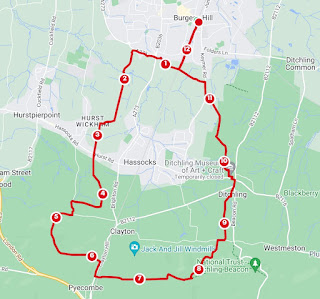Devils Humps and Jumps
I confess to being a little thrown by company on this walk but, on this occasion, my limited planning turned out well, for me, and not so well for my other half who was, frankly, broken by the 20 miler. The feeling is understood between us and we work well because our need for diversion is mutual. Another person might be annoyed by extra-curricular rambling and fence jumping but there is some accommodation here.
An early start was necessary to fit this route into daylight and I was nervous about over doing it. Fortunately, Kingley Vale with the ancient earthworks and magnificent yew trees was magical, on this clear and frosty day.
Burgess Hill to Bosham is an hour and a half via a Brighton train. The investment is worth it.
From Bosham station, we avoided the B2416 by a circuit on Williams Road. Turn northward to cross the tracks on Brooks Lane. Rejoin the main road from the bridleway. At the junction, turn right a little on Clay Lane and take the footpath on the left as it eventually enters the woods. East Ashling Farm leads to East Ashling. Follow the main road north as it joins Stoke Road. Leave this briefly to take a detour through Stoke Wood before rejoining it at a junction marked with a sign to the National Nature Reserve of Kingley Vale.
A footpath takes you to edge of this special place over Stoke Down. Mature yews lie all about. A couple of routes take you through. Ancient earthworks litter the bowl-like valley. We tried a few paths as they fizzled out amongst the brambles. A muntjac fled into the thickening undergrowth. We rejoined the obvious path directly upwards in the clearing. Views open up to the south, with The Solent beyond. At the top, go left to the barrows on the ridge. We enjoyed a cup of tea and a biscuit and I felt buoyant at the Devil's Humps.
Return to the junction and take the lower bridleway to Bow Hill. Somewhere on the right is the Tansley Stone but the trig is also nestled amongst the trees on the left so don't miss it. Earthworks abound and all require a little investigation to discern. The Iron Age Goose Hill Camp is no different and lies on the wooded slope on the right of the bridleway. Keep descending on the trail and you'll arrive at Chilgrove and over the road, The White Horse. The pub was open but not serving food until midday and so we made do with a coffee and a biscuit.
Onward, continue on the road round eastward then north to Yewtree Cottage. Now go northwestward on a tree lined path before emerging near Monkton Farm and walking past the remains of a medieval settlement. Follow the fence line on the left until you reach the South Downs Way. Swiftly, on the left, are the line of barrows known as the Devil's Jumps. Seriously impressive and irrestible to adults and children to run over. The alignment is coincident with the setting of the midsummer sun.
Continue through the wood and out for further views out towards the Isle of Wight on Didling Hill. Just after the trig at Linch Ball, take the bridleway south through Westdean Woods and the Nature Reserve. This is known for wild daffodils in the Spring. Onto the road, follow it east then round to the south and a remarkable tree-lined avenue. This was planted by the Surrealist Edward James, who lived at the bonkers Monkton House. We passed this on the South Downs Way but it is deeply hidden in the trees. On the route, you'll also have passed some Andy Goldsworthy chalk boulders and probably wondered what they were. There are 13 in all.
Cut the corner of the road by crossing a field and entering the trees and continue to descend on the road towards West Dean.
Now take The Centurion Way on the the dismantled railway, once through one of the tunnels. The railway was at an end in 1991 and this route will take you all the way back to Chichester, merging with the New Lipchis Way. Enter the Mid Lavant housing before rejoining the railway route under the A286. Sculptures begin here under the bridge and, once you reach Hunters Race Farm, there are the works of 'The Quarry' and the 'Chichester Road Gang'. At Brandy Hole Copse, leave and go east to join the main Lavant Road, where you find the Smugglers Stone, through the subway and all the way through to the Market Cross and beyond to the station.
S was hobbling and my feet were feeling it but Chichester's Roman roots made for a direct exit.


Comments
Post a Comment